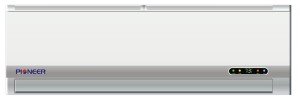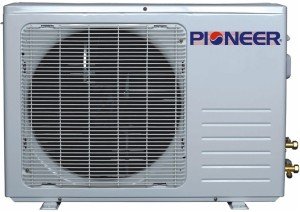A wall mounted air conditioner, also known as a ductless air conditioner or a split system air conditioner, is a great option when there is no room for a portable unit and/or the home does not support a ducted central air conditioner. Before installing, please be sure to check for any regulations in your city or town that may require installation by a professional.
How to Install a Wall Mounted Air Conditioner
There are a few things to keep in mind before committing to purchase a split wall mounted air conditioner. These types of units are called split system because they have two major components—an inside air handler that is mounted on the wall and an outside condenser. As in other types of air conditioning units, please verify that the size and the BTU of the unit can cool the area you are installing it in. Below are some basic instructions for installing this type of air conditioner. Please refer to the owner’s manual for specific instructions for your particular wall air conditioner.
The tools you will need to install the split wall mounted air conditioner:
-
Phillips head screw driver
-
Drill and appropriate drill bits
-
Wide tape
-
Copper tubing extension (depending on how far the air handler and the condenser will be from each other)
-
Bubble level
-
Flaring Tool (if needed)
You will need to determine where the inside air handler will be mounted. They are usually placed in the middle of the room, over door, or wherever the best air flow can happen. Keep in mind that you will need to run tubing from the inside air handler to the outside condenser so this may affect where you mount the unit. You will need to drill a hole in the wall for the tubing to reach the outside. The tubing will be made up of a condensation drain line and a refrigeration line set. There will also be an electrical power line running from the inside unit to the outdoor unit.
Select a place with proper support for the mounting bracket. Please follow your owner’s manual for specifics. You want to screw the bracket to studs whenever possible, but the mounting bracket kit will have wall screw brackets you need to hold up the unit in place. As the saying goes, measure and balance twice and drill once. In the US, if you are installing the unit on a typical sheet-rock wall, keep in mind that the large tubing hole must not run into a stud. This will not be an issue if you are drilling through a cement or brick wall. Be sure to level the bracket before drilling.
It is important to have enough space between the ceiling and the air handler for air flow purposes. Six inches (15 ¼ cm) would be a good distance. This will also allow you to put mount the air handler on the bracket with ease. Again, refer to your owner’s manual for more details.
One you have marked the appropriate mounting holes with a pencil or pen, drill into the wall. For the larger tubing hole, your bracket will most likely have a marking of where to drill. Please refer to your owner’s manual for specifics. This hole must be drilled at an angle to the water can drain out from the unit. You will need a larger hole drill bit for this hole. Typically, a 2 inch (5.08 cm) drill bit will work. Be sure that it is appropriate for the type of wall the unit will be on. Again, this hole must not run into any studs.
One the bracket is installed, the next step is to open the back of the unit and extend the tubing and any electrical chords. Because the pipes are made of copper, use extreme care when extending them. The plastic drainage tube needs to be placed under the two copper tube and taped together so that they fit through the opening in the wall.
You may want to install a cable or line cover on the outside for protections of the tubing and for aesthetics like this one.
Also, you may need to purchase additional copper tubing depending on the distance between the two units. Refer to owner’s manual for attachment of the copper tubing and the electrical power chord to the outside condenser. At this point, you will need to use a flaring tool if your unit calls for it. This is an example of one that works well. If you are using a flaring tool, remember to put the nut on before flaring the tube.
The drain pipe may need to be extended as well. You can use pvc pipe for this. You can tape the pvc pipe to the drainage tube and then secure the pipe to the outside wall with a c-clamp if needed. After this, you will need to attach the copper tubing and the power chord to the outside condenser. Because of the differences in voltage in units and countries, please refer to the owner’s manual for specifics on this.
Once the lines are connected, the next step is to check the outside unit for any leaks. Nitrogen is typically used for this. You can rent it from your local hardware store. If there is no outside power outlet, you will need to install one. This will require a professional.
Once you verify that there are not leaks and the unit is properly connected to a power source, you can open the valve to release the refrigerant that is already present in the unit. Again, refer to the owner’s manual.
If you have a done all the steps properly, you now have a working ductless air conditioner. Turn on the unit and enjoy!

